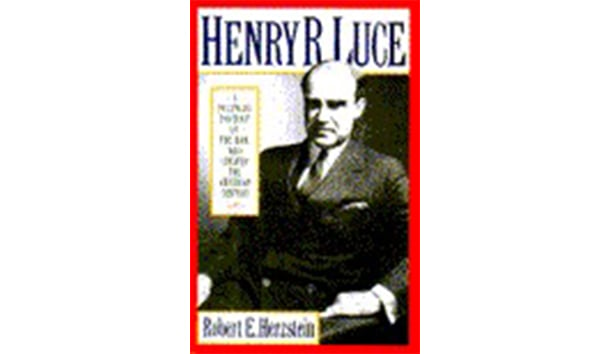Henry Luce both created and dominated a new form of national journalism between 1930 and 1960. Founder and editor-in-chief of Time, Life, and Fortune, he is best remembered for his 1941 Life essay “The American Century,” a robust call for the United States to assume world power status.
Robert Herzstein, Carolina Research Professor of History at the University of South Carolina, offers in Henry R. Luce: A Political Portrait of the Man Who Created the American Century a detailed analysis of the ideological makeup and consequences of this essay. The results are mixed. Able discussions of Luce’s use of his magazines to force political change and of symbolically important internal disputes among Time-Life editors are marred by a limited understanding of his subject’s goals, a confused point of view, and repeated genuflections to contemporary ideological demands.
“America First” enthusiasts will find a full-blooded villain in Herzstein’s portrait of Henry Luce. As early as 1920, the author reports, “Harry looked forward to helping America make the world safe for democracy, Christianity, and free enterprise.” Financially supported by the wealthy Chicago widow Hattie McCormick and boosted by his Yale and Skull and Bones credentials. Luce sought to remake the world. “Isolationism” was his regular foe, and he hoped to use American entry into a new European war to bury it, just as Lincoln had used the Civil War to bury slavery.
Oblivious to the conflict between a regime of liberty and the demands of a democratic empire, Luce consistently pressed for American intervention in European and Chinese affairs. For example, Herzstein details Luce’s considerable role in conceiving and selling to a “reluctant” Franklin Roosevelt the “Destroyer for Caribbean Bases” deal in the summer of 1940. Luce’s efforts in those months included close collaboration with “the Century Croup,” a cabal of New York-based internationalists “who believed in America’s global mission and their own right and duty to influence United States foreign policy” and who included the Reverend Henry Sloane Coffin, playwright Robert Sherwood, and Union Theological Seminary President Henry Pitney Van Dorn. They also involved timely production of the pro-intervention film The Ramparts We Watch by Luce’s “March of Time” division, private meetings and secret deals with Roosevelt himself, and the publishing of an unusually long essay in Time on “The Strategic Geography of the Caribbean Sea,” which cited the need for bases that only British colonies could supply.
The author shows how anticommunism supplanted antifascism in Luce’s scheme in 1945, including a fair appraisal of Whittaker Chambers’ influence in redirecting the American crusade within the pages of Time. He offers extensive treatment of Luce’s obsession with China. Born there as the son of an American missionary. Luce never wavered in his belief that Chiang Kai-shek represented China’s authentic soul and future. Among the fascinating details that Herzstein brings to light are lectures given by Luce’s own father in 1941 (which offered a far more accurate view of both Chiang and his communist rivals), as well as internal Time-Life memoranda deeply critical of the Nationalist regime, which Luce squelched.
Yet while sorting through Luce’s foreign policy agenda with some skill, Herzstein misses the related domestic goals implicit in Luce’s political vision. He skirts over Luce’s fairly deep attention to the American problems of consumerism and religious conflict, which led to a focus—respectively—on the “family-centered” suburbs and the attempted integration of Catholicism into the American myth. As Luce once explained, the goal of Life magazine was to instill a sense of history and destiny in the average American, to show “that ‘civilization’ isn’t just a word—it’s a something that ‘means you’!”
Part of the problem derives from Herzstein’s fairly overt hostility to religious expression of any sort. Found throughout the volume are sophomorically secular passages such as: “[Luce’s] father ruled, however gently, at home; the headmaster at school; and God, of course, governed all.” Or: “When Harry delivered a sermon on China in a church, proceeded and followed by processional, anthems, and organ postludes, he would describe China. . . . “
The author’s abhorrence of a traditional morality pops up in other ad hominem asides, including a description of Luce’s 1945 visit to his birthplace: “After surviving this ordeal. Luce arrived in Chengtu. There, he heard that the Chinese ran two whorehouses, one fair and one good. He made no inspections. Instead, Harry toured the college campus, where he took tea with some of the students.” Still more disturbing are passages such as this commentary on women editors working at Time Inc. in the 1940’s: “Perhaps they were afraid of bumping into a glass ceiling, which Luce, like many contemporary employers, had built but could not see. Ultimately, things began to change, but not until many years of pressure had eroded traditional prejudices.”
Not content to describe the America he discovered and observed, Henry Luce worked with considerable success to remold it into the image formed by a small boy in a Chinese missionary compound. Despite kowtows to his colleagues in the faculty lounge, Herzstein’s book does add new details and insights to the emerging portrait of Luce as ideologue and architect of “the American Way.”
[Henry R. Luce: A Political Portrait of the Man Who Created the American Century, Robert E. Herzstein (New York: Charles Scribner’s Sons) 521 pp., $30.00]

Leave a Reply